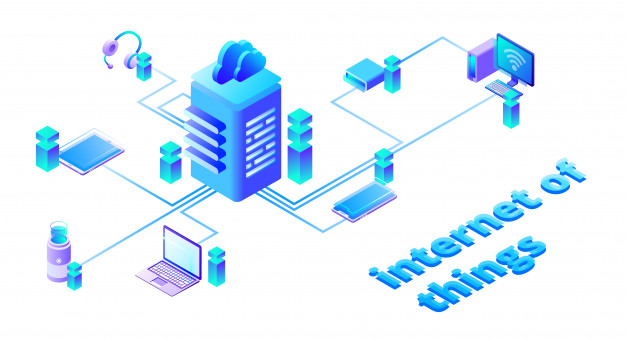The Smart devices, shuffling down the tech industry has made us accustomed to hearing the footsteps of one after another of their kinds. When those technologically superior, toy-like devices arrived, the ones with foresight among us predicted a more connected and more integrated internet.
They were darn right!
The Internet of Things (IoT) constitute the internet that they predicted.
But what is it? How does it work? And more importantly, what takeaways it offers to a digital marketer? I’ll discuss all these in this article.
The Internet of Things
Even though it appears as a breakfast item, kept in the refrigerators of the techies, the non-techies too can have a taste of it. The only thing they need to understand is the difference between the IPv4 Ipv6 protocols.
Why IPv6 prevailed?
Assuming the readers are non-techies, here’re the basics; every program or computational entity has a certain amount of memory allocated to it, which determines its address space.
IPv4, the outdated protocol supports source and destination addresses that are 32-bits long. IPv6, however, supports 128-bits address spaces. That’s the key reason it’s the de facto protocol of today’s internet.
What does it imply?
The implication is pretty astounding; we humans can assign an IPv6 address to every single entity in this world, and there’ll still be plenty addresses left to assign. In other words, we can identify everything on earth in terms of IPv6 addresses.
At this point, you can legitimately wonder the following:
Identification through networking is a bipartite process, and since many objects are not a part of the wired/wireless networking, we can’t assign them addresses.
That’s right, but there’s something you haven’t considered that can fill the gap.
Sensors.
The role of sensors
A sensor does the most important job – it converts a person or an entity into a “thing.” An example can help you understand it better; suppose you are driving a car with a built-in sensor to monitor the tire pressure. The is turning your car into a “thing”.
The success of Internet of Things (IoT), therefore, depends largely on the number of sensors. As the number increases, more and more “things” come into being, and as they get connected to each other, better communication prevails. So sensors play a crucial role in the development of Internet of Things (IoT).
The smart technologies
All smart devices have sensors in them. A device with scores of sensors has a better prospect in the market than a device that doesn’t have too many of them. iPhone 6 showcased multiple sensors to serve varied purposes and somewhat forced the competitor Smartphone brands to acknowledge their importance.
iPhone 6 is only an example, there are various other devices that either have fascinating built-in sensors in them or function as sensors themselves. Those devices can account for a rapid spread of the Internet of Things (IoT).
Digital marketing and IoT
IoT can mark a new era in digital marketing. With the emerge of IoT, the online marketing industry will become dependent on smart devices, more specifically on sensors. It will acknowledge the following things:
- Smart home technologies that are capable of learning human behavior and that adjust themselves to suit our preferences.
- Wearables to track pulse rate, blood pressure, etc.
- 3D scanners that can print consumer products.
Today’s digital marketing trends and techniques will be overhauled to the extent that it’d be difficult in the future to recognize them. For example, when online marketers go hammer and tong to help a site come in Google’s top ranking, they mostly keep the desktop interface in mind.
But the “things” or the atoms are rarely desktop computers. They are handheld devices that can comfortably fit inside one’s pocket. Everything including the search interface and the way to access information will be different. Hence, digital marketers will have to revamp their existing marketing strategies.
Opportunities presented by IoT
Alongside challenges, IoT presents plenty of opportunities to the internet marketers. The following are some of the opportunities:
- Speedy and smooth accumulation of consumer data.
- Seamless pattern detection.
- Better information processing owing to the integrated version of Internet.
All these will act as leverages enabling an internet marketer to personalize a brand image and gain a better understanding of the market.
How IoT is changing digital marketing in 2020 and for years to come
- The possibility of 100% CTR
Digital marketers spend a lot on unfruitful advertising. With the advancements in the IoT technology, advertisements in the near future are expected to be 100% aligned with the behaviors, interests, requirements, and previous purchases of a consumer.
For example, in case a light bulb dies in a “smart house,” the home will immediately record a need for a replacement.
- Next level social media marketing
Social media’s dominance in the digital marketing sector has simply been indisputable, yielding satisfactory results. IoT would play a key role in automating the process, curating automated posts, and intelligently share the same with a targeted relevant audience.
- Next level product-development data
Conventional product development used to depend a lot on customer feedback and one-way information flow.
Due to its integral reliance on feedback from customers, ready implementation into additional product iterations could not be made possible.
With the advancements in IoT, data on product usage can be accessed by manufacturers in real-time, thus, enabling them to make quick corrections (wherever needed) and rapid improvements in design based on the data.
- Predictive ads
Ads don’t have to be so annoying now, thanks to the IoT technology. IoT can make it possible for advertisements to be 100% relevant according to customer data making them come up exactly at the right time.
Savvy marketers are already embracing the huge potential of the IoT technology in their digital marketing campaigns by providing highly relevant and personalized experience to their customers. Do not miss out.




